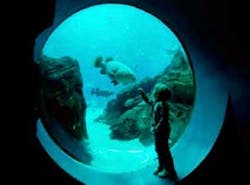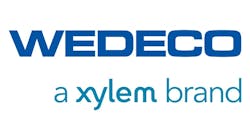The Georgia Aquarium, located in the heart of Atlanta, opened its doors in 2005 as the world’s largest aquarium, with 100,000 freshwater and saltwater aquatic residents in 10 million gal of water. The aquarium houses more than 60 exhibits spread over six distinct galleries, with each gallery corresponding to a specific environment and theme.
Scope
The aquarium system operates as a closed loop and is able to recapture and reuse over 99% of the water in its exhibits. In order to reuse the majority of the tank water, the aquarium must ensure that waste from its aquatic residents is removed. This entails an elaborate water purification system that pumps and filters the entire 10 million gal for a complete turnover of the tank water approximately every 1.5 hours.
The entire treatment process is controlled by a specially designed computer system that monitors temperature, tank levels and the flow of water through the system. A team of life support staff works in rotating shifts to provide additional around-the-clock support, conducting tests and assisting with interpreting the water quality data collected. Although oxidation with ozone appears straightforward, the reality is far more complex. For Eric Hall and his team of life support staff, the biggest challenge is balancing water quality with water clarity, which are not the same thing.
“Healthy water is not always clear and clear water is not always healthy,” said Hall.
The health of the aquatic species actually requires a much lower level of water clarity than the clarity required for the optimal viewing experience for the public. However, public engagement and education is a vital part of the aquarium’s mission, and viewing clarity is central to that goal. Balancing these two oft-opposing goals—clarity for public viewing and water quality for species health—requires frequent adjustment.
Solution
When choosing a partner to provide ozone expertise and equipment, Hall needed someone who understands the industry and this delicate balance between water quality and water clarity. Wedeco has years of experience serving all the SeaWorld parks worldwide and were familiar with the special needs of aquatic species—both marine and freshwater.
With an established record for reliability and care of the client during the design, through construction and after startup, Wedeco had the expertise and experience that provided the needed trust and comfort level.
Wedeco enters the aquarium water treatment process in the final stage, which involves the use of ozone to both disinfect the water and assist with maintaining the clarity needed for optimal viewing of the aquatic life through the tanks’ thick acrylic windows. Liquid oxygen generated on site is passed through eight Wedeco ozone generators. Two Wedeco SMO 40 generators provide ozone to treat water for the main exhibits while smaller SMO 10 and GSO 30 ozone generators provide disinfection for the other galleries. Farther along in the treatment stage, any leftover ozone from the contact tanks is passed through Wedeco catalytic destructors (models VOD 400 and VOD 200) to ensure that ozone does not escape to the environment. Disinfected water is pumped through a de-aeration tower, which agitates the water to remove excess gases and is then returned to the exhibit tanks before the cleaning cycle is repeated.
Result
Ozone has proven its ability to meet multiple treatment objectives and provide crystal-clear water quality to meet the goals of the aquarium—safeguarding the health of its residents and providing a connection with the public. Alan Grosse, a life support systems technician who oversees the operation and service of the ozone systems, sums up the benefits of using ozone for water reuse at the aquarium when he says the ozone provides “the needed disinfection for the tank water to protect the animals in our care and helps in keeping the water as clear as possible, giving visitors the clear view that makes all the difference.”



